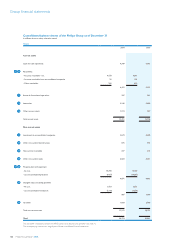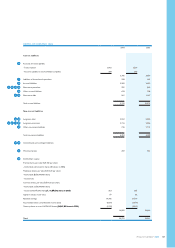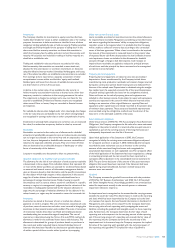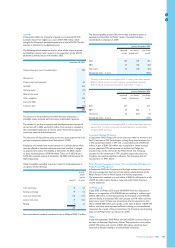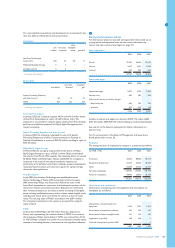Philips 2005 Annual Report Download - page 135
Download and view the complete annual report
Please find page 135 of the 2005 Philips annual report below. You can navigate through the pages in the report by either clicking on the pages listed below, or by using the keyword search tool below to find specific information within the annual report.
Philips Annual Report 2005 135
Investments
TheCompanyclassiesitsinvestmentsinequitysecuritiesthathave
readily determinable fair values as either available-for-sale or for trading
purposes.Investmentsindebtsecuritiesareclassiedinoneofthree
categories: trading, available-for-sale or held-to-maturity. Trading securities
are bought and held principally for the purpose of selling them in the
short term. Held-to-maturity securities are those debt securities in
which the Company has the ability and intent to hold the security until
maturity. All securities not included in trading or held-to-maturity are
classiedasavailable-for-sale.
Trading and available-for-sale securities are recorded at fair value.
Held-to-maturity debt securities are recorded at amortized cost,
adjusted for the amortization or accretion of premiums or discounts
using the effective interest method. Unrealized holding gains and losses,
net of the related tax effect, on available-for-sale securities are excluded
from earnings and are reported as a separate component of other
comprehensive income within stockholders’ equity until realized.
Realized gains and losses from the sale of available-for-sale securities
aredeterminedonarst-in,rst-outbasis.
A decline in the market value of any available-for-sale security or
held-to-maturity security below cost that is deemed to be other than
temporary results in a reduction in the carrying amount to fair value.
The impairment is charged to earnings, and a new cost basis for the
security is established. Dividend and interest income are recognized
whenearned.Gainsorlosses,ifany,arerecordedinnancialincome
and expenses.
For available-for-sale securities hedged under a fair value hedge, the changes
in the fair value that are attributable to the risk which is being hedged
are recognized in earnings rather than in other comprehensive income.
Investments in privately-held companies are carried at cost, or estimated
fair value, if an other-than-temporary decline in value has occurred.
Receivables
Receivables are carried at face value, net of allowances for doubtful
accounts and uncollectible amounts. As soon as trade accounts receivable
can no longer be collected in the normal way and are expected to result
in a loss, they are designated as doubtful trade accounts receivable and
valued at the expected collectible amounts. They are written off when
they are deemed to be uncollectible because of bankruptcy or other
forms of receivership of the debtors.
Long-term receivables are discounted to their net present value.
Valuation adjustment for doubtful trade accounts receivable
The allowance for the risk of non-collection of trade accounts receivable
is determined in three stages. First, individual debtors that represent 3%
or more of the debtor portfolio are assessed for creditworthiness based
on external and internal sources of information; management decides
uponanallowancebasedonthatinformationandthespeciccircumstances
for that debtor which might require a value adjustment. In the second
stage, for all other debtors the allowance is calculated based on a
percentageofaveragehistoricallosses.Finally,if,owingtospecic
circumstancessuchasseriousadverseeconomicconditionsinaspecic
country or region, it is management’s judgment that the valuation of the
receivables is inadequately represented by the valuation allowance in
stage two, the percentage of valuation allowance for the debtors in the
related country or region may be increased to cover the increased risk.
Inventories
Inventories are stated at the lower of cost or market, less advance
payments on work in progress. The cost of inventories comprises all costs
of purchase, costs of conversion and other costs incurred in bringing the
inventories to their present location and condition. The costs of conversion
ofinventoriesincludedirectlaborandxedandvariableproduction
overheads, taking into account the stage of completion. The cost of
inventoriesisdeterminedusingtherst-in,rst-out(FIFO)method.An
allowance is made for the estimated losses due to obsolescence. This
allowance is determined for groups of products based on purchases in
the recent past and/or expected future demand. Individual items of
inventorythathavebeenidentiedasobsoletearetypicallydisposed
of within a period of three months either by sale or by scrapping.
Othernon-currentnancialassets
Loans receivable are stated at amortized cost, less the related allowance
for impaired loans receivable. Management, considering current information
and events regarding the borrowers’ ability to repay their obligations,
considers a loan to be impaired when it is probable that the Company
will be unable to collect all amounts due according to the contractual
terms of the loan agreement. When a loan is considered to be impaired,
the amount of the impairment is measured based on the present value
ofexpectedfuturecashowsdiscountedattheloan’seffectiveinterest
rate. Impairment losses are included in the allowance for doubtful
accounts through a charge to bad debt expense. Cash receipts on
impaired loans receivable are applied to reduce the principal amount
of such loans until the principal has been recovered and are recognized
as interest income thereafter.
Property, plant and equipment
Property, plant and equipment are stated at cost, less accumulated
depreciation. Assets manufactured by the Company include direct
manufacturing costs, production overheads and interest charges incurred
during the construction period. Government grants are deducted from
the cost of the related asset. Depreciation is calculated using the straight-
line method over the expected economic life of the asset. Depreciation
of special tooling is generally also based on the straight-line method.
Gains and losses on the sale of property, plant and equipment are
included in other business income. Costs related to repair and maintenance
activities are expensed in the period in which they are incurred unless
leading to an extension of the original lifetime or capacity. Plant and
equipment under capital leases are initially recorded at the present value
of minimum lease payments. These assets and leasehold improvements
are amortized using the straight-line method over the shorter of the
lease term or the estimated useful life of the asset.
Asset retirement obligations
Under the provisions of SFAS No. 143, ‘Accounting for Asset Retirement
Obligations’, the Company recognizes the fair value of an asset retirement
obligation in the period in which it is incurred, while an equal amount is
capitalized as part of the carrying amount of the long-lived asset and
subsequently depreciated over the life of the asset.
Upon initial application of the Statement in 2003, the Company
recognized a liability for existing asset retirement obligations adjusted
for cumulative accretion to January 1, 2003. Additionally, the Company
recorded the asset retirement cost as an increase to the carrying
amounts of the associated long-lived assets and recognized the
accumulated depreciation on such capitalized cost. The cumulative effect
of the initial application of the Statement has been recognized as a change
in accounting principle and the net amount has been reported as a
cumulative-effect adjustment in the consolidated income statement for
2003. The pro forma disclosure of the amount of the asset retirement
obligation that would have been reported if the Statement had been
applied during all periods affected, has been omitted because the
amounts were not material.
Goodwill
The Company accounts for goodwill in accordance with the provisions
of SFAS No. 141 ‘Business Combinations’ and SFAS No. 142 ‘Goodwill
and Other Intangible Assets’. Accordingly, goodwill is not amortized but
tested for impairment annually in the second quarter or whenever
impairment indicators require so.
An impairment loss is recognized to the extent that the carrying amount
exceeds the asset’s fair value. This determination is made at the reporting
unit level, which has been determined by the Company to be the level
ofabusinessthatreportsdiscretenancialinformationtotheBoardof
Management, and consists of two steps. First, the Company determines
the carrying value of each reporting unit by assigning the assets and
liabilities, including the goodwill and intangible assets, to those reporting
units. Furthermore, the Company determines the fair value of each
reporting unit and compares it to the carrying amount of the reporting
unit. If the carrying amount of a reporting unit exceeds the fair value of
the reporting unit, the Company performs the second step of the
impairment test. In the second step, the Company compares the implied
fair value of the reporting unit’s goodwill with the carrying amount of
the reporting unit’s goodwill. The implied fair value of goodwill is



